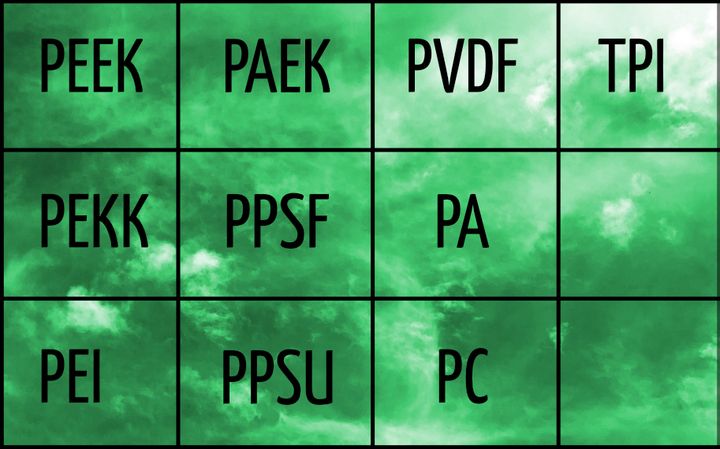
In the last 2-3 years there has been a dramatic rise in high-temperature 3D printing, but what are the materials for this type of printing?
For many years most thermoplastic 3D printing was limited to a very small subset of thermoplastics, mainly PLA and ABS, with a bit of PETG. That’s still the case for most desktop equipment, but there have been many commercial devices developed that can handle materials at far higher temperatures.
Higher-temperature materials are extremely useful because they can be applied in more environments. Consider a plastic part in an automobile engine: it would soften or even melt if exposed to sufficiently high temperatures. But if it was made from a material that had higher heat resistance it might be usable.
That’s desirable because plastic parts are often lighter than their metal counterparts, which is advantageous in many ways, particularly in the automotive and aerospace industries. Thus there’s been a bit of rush towards these high-temperature 3D printed parts.
The open-style desktop 3D printers are entirely inadequate for 3D printing high-temperature materials as the heat required must certainly be enclosed and precisely controlled. Several 3D printer manufacturers have emerged recently that focus specifically on this type of machine and material, including Roboze, INTAMSYS, Minifactory and others. Some traditional manufacturers, such as Stratasys, offer high-temperature thermoplastic material options as well.
But what are these materials? What are their properties and how can they be used in 3D printing?
PEEK
Chemical name “Polyether ether ketone”, this polymer is actually part of the PAEK family and apparently was invented by Victrex in the UK in the 1980s. It’s become one of the most popular high-temp 3D printing materials as it provides significant robustness and therefore is often used for high-stress applications.
PEKK
Chemical name ”Polyetherketoneketone”, this emerging 3D print material is becoming more popular. PEKK is quite similar to PEEK in more than just its name, as they share many common properties. However, PEKK is able to withstand far greater compressive force. It also tends to have a slightly higher heat resistance level than PEEK.
PEI
Chemical name “Polyetherimide”, and also found under the trade name “ULTEM”, a brand of SABIC. It was one of the first high-temp 3D print materials, offered by Stratasys as a material option on their Fortus equipment. While less expensive than PEEK, it also has somewhat less thermal resistance and strength. It’s often used in aerospace applications.
PPSU / PPSF
Chemical name “Polyphenylsulfone”. This material offers high strength and chemical resistance. A unique property is that it has no melting point, according to Wikipedia, which says this is due to its amorphous internal structure. Several companies offer this material option, including Stratasys.
PAEK
Chemical name “Polyaryletherketone”. This material is a relative newcomer to the high-temperature 3D printing space, but it has extremely high temperature resistance of up to 350C, and has less toxin emissions when burned than other high-temperature materials. This allows it to be used in applications where human exposure may occur.
PC
Polycarbonate refers to a class of polymers integrating carbonate in their structure. PC is a very popular material as it offers great durability, as well as very high impact and scratch resistance. As such it is commonly used in consumer products.
PA
Polyamides are a very common 3D printing material, although it may be hard to justify them as being a high-temperature material as some have relatively low glass transition temperatures as compared to other materials on this list. There are several species of PA, usually designated by a number: PA-6, PA-11, PA-12, PA-66, etc. They are also referred to as “nylons”.
PVDF
Chemical name ”Polyvinylidene fluoride”. This is a very new material to 3D printing, currently supported only by a few 3D printer manufacturers, including Minifactory. The main claim of PVDF is that it is almost completely non-reactive to other materials, thus making it suitable for specific applications where exposure is required, including biomedical applications.
TPI
Thermoplastic polyimide seems to be at only the research stage of 3D printing, where we look to a 2018 paper where researchers tested the possibility of 3D printing with TPI. They found the optimum extrusion temperature for TPI to be 335C, qualifying it for this list. TPI offers abrasion resistance, high-temperature resistance and long-term durability. It could become another material for 3D printing in the future.
High-Temperature 3D Print Material Variations
The above list includes the basic materials, but you’ll find a vastly greater selection in the marketplace simply due to variations.
For example, SABIC offers over 100 unique grades of ULTEM, each having slightly different properties. Some are chemically different, while others are composite materials, where different substances are mixed in with the polymer.
Typical composite variations of the above materials may include the addition of glass fiber to strengthen the prints. Another very popular composite additive is carbon fiber segments, which, although chopped, still offer a significant strength advantage over the polymer alone.
Some variations offer unusual properties, such as ESD rating. These materials are able to prevent electrostatic discharges, which enables their use in specific flammable situations involving.
While the choice of materials is made based on the requirements of the application, there’s another choice to be made: support materials. For many 3D prints overhangs could require supports. Unfortunately, many of the most commonly used support materials are not valid for high-temperature 3D printing since the chamber temperatures will be far higher than their melting points. Thus there are a few specific support materials available for high-temperature applications.
Finally, there’s the possibility of high-temperature thermoset materials. Unlike the thermoplastics used in extrusion-based 3D printing that can be repeatedly softened and hardened, thermosets harden exactly once. Some variations of thermoset mixtures are capable of handling higher temperatures, but for most high-temperature applications the materials above are typically selected.
